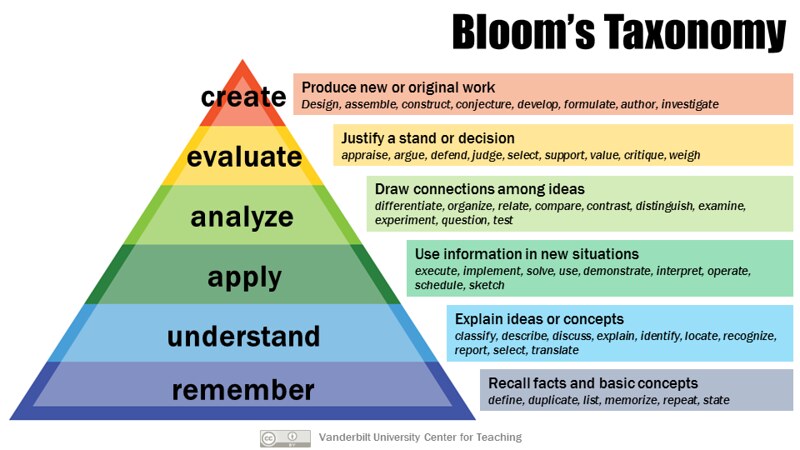Bloom’s Taxonomy: how to set learning objectives basing on training needs
The Training Need Analysis phase is part of all ISD models and aims to identify the gap between knowledge and skills owned by students and learning objectives to achieve, which can be defined using categorisations like Bloom’s Taxonomy.
How are these objectives classified and how can this help instructional design? Keep reading to find out.
TRAINING NEED ANALYSIS: WHO ARE YOUR STUDENTS?
Instructional design, both for digital or face-to-face training, is a crucial step to ensure a good outcome in terms of effectiveness and usefulness for students. In order to clearly define training needs and, therefore, set objectives to achieve, it is necessary to devote some time to study your audience, namely those people that will become your target “class”.
To do so, a process called Training Need Analysis comes into play. It has the goal to describe the starting point for the training process: cultural background, level of education, level of digital literacy, age, interests, all these are factors that may affect learning and that you need to take into account to design your training process effectively.
LEARNING OBJECTIVES
Once you have your students’ profiles, then, the second step of the analysis phase is to define the desired learning objectives, namely which results you aim to achieve at the end of the training period. It is important to note that these objectives are not strictly related to a set of information to store up, but need to be thought more generally as a whole knowledge, know-how and know how to be.
BLOOM’S TAXONOMY
To analyse needs and set learning objectives, instructional designers can get help from categorisations to select, among all possible educational outcomes identified, the most useful ones for the specific training process. The most famous of these categorisations is without any doubt Bloom’s Taxonomy, created by Benjamin Bloom and his collaborators Max Englehart, Edward Furst, Walter Hill and David Krathwohl. Their work, published in 1956, aimed to define a “Taxonomy of Educational Objectives” and was initially used by K-12 (kindergarten to 12th grade) teachers and college instructors.

This taxonomy was composed by six main categories, among which Knowledge was considered a necessary precondition: it involved “the recall of specifics and universals, the recall of methods and processes, or the recall of a pattern, structure, or setting”. Skills and abilities were categorised in Comprehension, Application, Analysis, Synthesis, and Evaluation, namely interpreting, abstracting from concrete situations, breaking down, putting together and judging about “the value of material and methods for given purpose”.
BLOOM’S REVISED TAXONOMY
A recognised limit of the original Bloom’s Taxonomy was related to being quite static and applicable to limited target audiences. Therefore, in 2001, Anderson and Krathwohl published a revised version, defining it “a taxonomy for learning, teaching, and assessing”, with two main differences.
Their desire to point to a more dynamic conception of classification was reflected in the choice of using action verbs and gerunds instead of the nouns of the original model: these seem to better “describe the cognitive processes by which thinkers encounter and work with knowledge”. That dynamism also aims to broad the target audience and allow the use of the new taxonomy for different curriculum planning.
In addition to that, the original one-dimensional structure turned into a two-dimensional one, with two different classifications for Cognitive Processes and Knowledge. The first ones, intended as processes used to learn, retrace original skills and abilities: Remember, Understand, Apply, Analyse, Evaluate, Create. The second one is instead intended as what to learn and is composed by factual knowledge, conceptual knowledge, procedural knowledge and metacognitive knowledge, including all aspects of knowledge with a theoretical and practical approach.
THE IMPORTANCE OF SETTING LEARNING OBJECTIVES
Using classifications like Bloom’s Taxonomy can seem complex and a waste of time, but it can be a great help for the needs analysis and definition of objectives. Why is this step so important?
First of all, its outcome is the starting point for the following phases, which could become less effective if based on weak and unclear premises, even if handled perfectly. This can affect the design of any training process, as we said, in terms of time and costs, especially if that includes eLearning.
Secondly, defining objectives clearly is useful to expand the results you aim to reach: not only knowledge transferred from trainer to student, but a set of abilities and skills that can improve the learner’s performance on a work, management and social level.
Having a clear vision of your students’ background and of the direction you want to steer them to is crucial for the following step of instructional design: the creation of educational plans with all the useful elements to achieve the set objectives. Do you want to know how this process works? Read our next articles!
REFERENCES
Bloom, B. S. et al. (1956), Taxonomy of educational objectives: The classification of educational goals. Handbook I: Cognitive domain.
Patricia Armstrong, Vanderbilt University, Bloom’s Taxonomy
University of Waterloo, Bloom’s Taxonomy
Anderson-Krathwohl (2001) A Taxonomy for Learning, Teaching, and Assessing
Mary Forehand, The University of Georgia, Bloom’s Taxonomy


